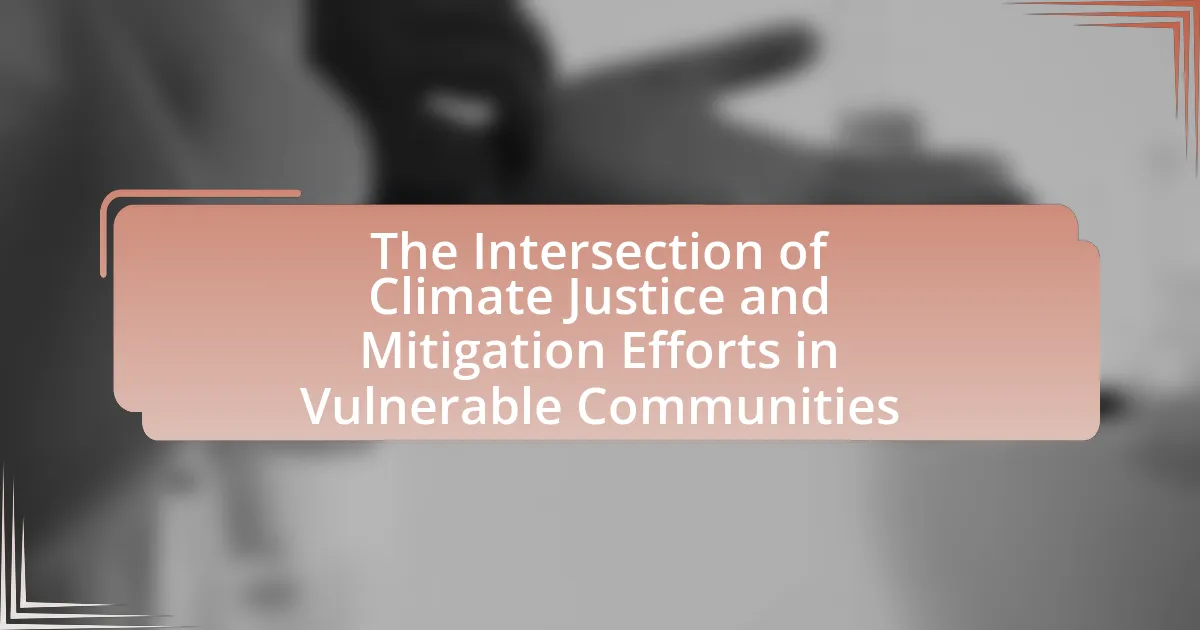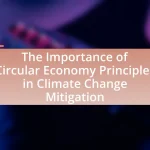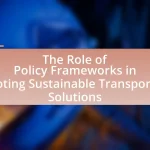The article examines the intersection of climate justice and mitigation efforts in vulnerable communities, highlighting the disproportionate impacts of climate change on marginalized populations. It discusses how socio-economic factors contribute to their vulnerability and the importance of equitable access to resources, clean energy, and sustainable infrastructure. Key mitigation strategies, such as community-led initiatives and policy advocacy, are explored, emphasizing the need for collaboration among governments, NGOs, and local communities to enhance resilience and address systemic inequalities. The article also outlines the ethical implications of climate justice and the role of grassroots movements in advocating for effective climate action.

What is the Intersection of Climate Justice and Mitigation Efforts in Vulnerable Communities?
The intersection of climate justice and mitigation efforts in vulnerable communities involves addressing the disproportionate impacts of climate change on marginalized populations while implementing strategies to reduce greenhouse gas emissions. Vulnerable communities often face greater risks from climate-related disasters, such as flooding and heatwaves, due to socioeconomic factors, limited resources, and inadequate infrastructure. Effective mitigation efforts must therefore prioritize these communities by ensuring equitable access to clean energy, sustainable transportation, and climate-resilient infrastructure. Research indicates that inclusive climate policies can enhance resilience and promote social equity, as seen in initiatives like community solar projects that empower low-income households to participate in renewable energy solutions.
How do climate justice and mitigation efforts relate to vulnerable communities?
Climate justice and mitigation efforts are crucial for vulnerable communities as they address the disproportionate impacts of climate change on these populations. Vulnerable communities often face higher risks from climate-related disasters, such as floods and heatwaves, due to factors like poverty, lack of resources, and inadequate infrastructure. Mitigation efforts, which aim to reduce greenhouse gas emissions and promote sustainable practices, can help alleviate these risks by fostering resilience and adaptive capacity in these communities. For instance, studies show that investing in renewable energy and sustainable agriculture in low-income areas not only reduces emissions but also creates jobs and improves local economies, thereby enhancing community resilience against climate impacts.
What defines vulnerable communities in the context of climate change?
Vulnerable communities in the context of climate change are defined by their heightened exposure to climate-related risks and their limited capacity to adapt to these changes. These communities often include low-income populations, marginalized groups, and those living in environmentally degraded areas, which makes them more susceptible to the impacts of climate events such as floods, droughts, and extreme weather. According to the Intergovernmental Panel on Climate Change (IPCC), these groups face significant barriers such as inadequate infrastructure, lack of access to resources, and social inequalities, which exacerbate their vulnerability.
How do socio-economic factors influence vulnerability to climate change?
Socio-economic factors significantly influence vulnerability to climate change by determining access to resources, adaptive capacity, and exposure to climate risks. Communities with lower income levels often lack the financial means to invest in resilient infrastructure, healthcare, and education, which are crucial for adapting to climate impacts. For instance, a study by the Intergovernmental Panel on Climate Change (IPCC) highlights that poorer populations are more likely to live in high-risk areas, such as floodplains or urban heat islands, increasing their exposure to climate-related hazards. Additionally, limited access to information and technology further exacerbates their vulnerability, as these communities may not receive timely warnings or have the means to implement effective adaptation strategies.
Why is addressing climate justice important for vulnerable communities?
Addressing climate justice is crucial for vulnerable communities because these groups disproportionately experience the adverse effects of climate change while having the least capacity to adapt. Vulnerable communities often include low-income populations, indigenous peoples, and marginalized groups who face systemic inequalities. For instance, according to the Intergovernmental Panel on Climate Change (IPCC), these communities are more likely to suffer from extreme weather events, food insecurity, and health risks due to climate impacts. By prioritizing climate justice, policies can be designed to ensure equitable access to resources, support resilience-building efforts, and promote inclusive decision-making processes that empower these communities to address their unique challenges effectively.
What are the ethical implications of climate justice?
The ethical implications of climate justice center on the equitable distribution of environmental benefits and burdens, particularly affecting marginalized communities. Climate justice emphasizes that those who contribute least to climate change, often low-income and vulnerable populations, disproportionately suffer its impacts, such as extreme weather events and health risks. This disparity raises moral questions about responsibility and fairness, necessitating that wealthier nations and corporations take accountability for their historical emissions and support adaptation efforts in affected regions. Research indicates that addressing these ethical concerns can lead to more effective climate policies, as seen in the 2015 Paris Agreement, which acknowledges the need for equity in climate action.
How does climate injustice manifest in vulnerable communities?
Climate injustice manifests in vulnerable communities through disproportionate exposure to environmental hazards, limited access to resources, and inadequate representation in decision-making processes. Vulnerable communities, often characterized by low income and marginalized status, face higher risks from climate change impacts such as flooding, heatwaves, and air pollution. For instance, a study by the National Oceanic and Atmospheric Administration (NOAA) found that low-income neighborhoods are more likely to experience extreme heat events, exacerbating health issues. Additionally, these communities frequently lack the financial means to adapt to climate changes, resulting in increased vulnerability. Furthermore, they are often excluded from policy discussions, leading to decisions that do not reflect their needs or concerns, as highlighted in the report “Climate Justice: A Call to Action” by the United Nations.
What are the key mitigation efforts aimed at supporting vulnerable communities?
Key mitigation efforts aimed at supporting vulnerable communities include enhancing access to renewable energy, implementing climate-resilient infrastructure, and providing financial assistance for adaptation measures. These efforts are crucial as they directly address the disproportionate impacts of climate change on marginalized populations. For instance, the International Renewable Energy Agency reported that expanding renewable energy access can reduce energy poverty for over 1 billion people, thereby improving their resilience to climate-related shocks. Additionally, investing in climate-resilient infrastructure, such as flood defenses and sustainable agriculture practices, helps protect vulnerable communities from extreme weather events. Financial assistance programs, such as those offered by the Green Climate Fund, enable these communities to implement necessary adaptation strategies, ensuring their long-term sustainability and security.
What types of mitigation strategies are most effective for these communities?
Effective mitigation strategies for vulnerable communities include community-based adaptation, renewable energy initiatives, and sustainable land management practices. Community-based adaptation empowers local populations to develop tailored solutions that address specific climate risks, enhancing resilience. Renewable energy initiatives, such as solar and wind projects, reduce reliance on fossil fuels and lower greenhouse gas emissions, while also providing economic opportunities. Sustainable land management practices, including agroecology and reforestation, improve food security and biodiversity, contributing to long-term ecological health. These strategies have been shown to significantly reduce vulnerability and enhance adaptive capacity in communities facing climate change impacts.
How do local and global policies impact mitigation efforts?
Local and global policies significantly shape mitigation efforts by establishing frameworks that guide resource allocation, regulatory measures, and community engagement. Local policies, such as zoning laws and building codes, directly influence how communities adapt to climate change by promoting sustainable practices and resilience strategies. For instance, cities that implement strict emissions regulations can reduce greenhouse gas outputs, leading to improved air quality and public health outcomes.
Global policies, like the Paris Agreement, create binding commitments for countries to reduce emissions, fostering international cooperation and accountability. These agreements encourage nations to share technology and funding, which can enhance local mitigation efforts, particularly in vulnerable communities that may lack resources. Research shows that countries adhering to global climate targets have seen a 25% reduction in emissions compared to those without such commitments, highlighting the effectiveness of coordinated policy action.
Thus, both local and global policies are crucial in driving effective mitigation strategies, ensuring that vulnerable communities receive the support needed to combat climate change impacts.
How can we measure the effectiveness of climate justice initiatives?
The effectiveness of climate justice initiatives can be measured through specific indicators such as community engagement, policy impact, and environmental outcomes. Community engagement can be assessed by evaluating participation rates in initiatives and feedback from affected populations, which reflects the inclusivity of the process. Policy impact can be measured by analyzing changes in legislation or funding allocations that prioritize vulnerable communities, demonstrating a shift towards equitable resource distribution. Environmental outcomes can be quantified through metrics like reductions in greenhouse gas emissions or improvements in local biodiversity, which indicate the tangible benefits of these initiatives. For example, a study by the United Nations Development Programme highlighted that initiatives focusing on marginalized communities led to a 30% increase in local resilience to climate impacts, providing concrete evidence of effectiveness.
What challenges do vulnerable communities face in implementing mitigation efforts?
Vulnerable communities face significant challenges in implementing mitigation efforts, primarily due to limited financial resources, lack of access to technology, and insufficient political representation. Financial constraints hinder these communities from investing in necessary infrastructure and sustainable practices, as evidenced by a report from the United Nations Development Programme, which highlights that low-income areas often lack the capital needed for climate adaptation projects. Additionally, the absence of advanced technology restricts their ability to adopt efficient energy solutions, as noted in research by the International Renewable Energy Agency, which states that many vulnerable regions do not have the means to access or implement renewable energy technologies. Furthermore, inadequate political representation often results in these communities being overlooked in policy-making processes, limiting their ability to advocate for necessary support and resources.
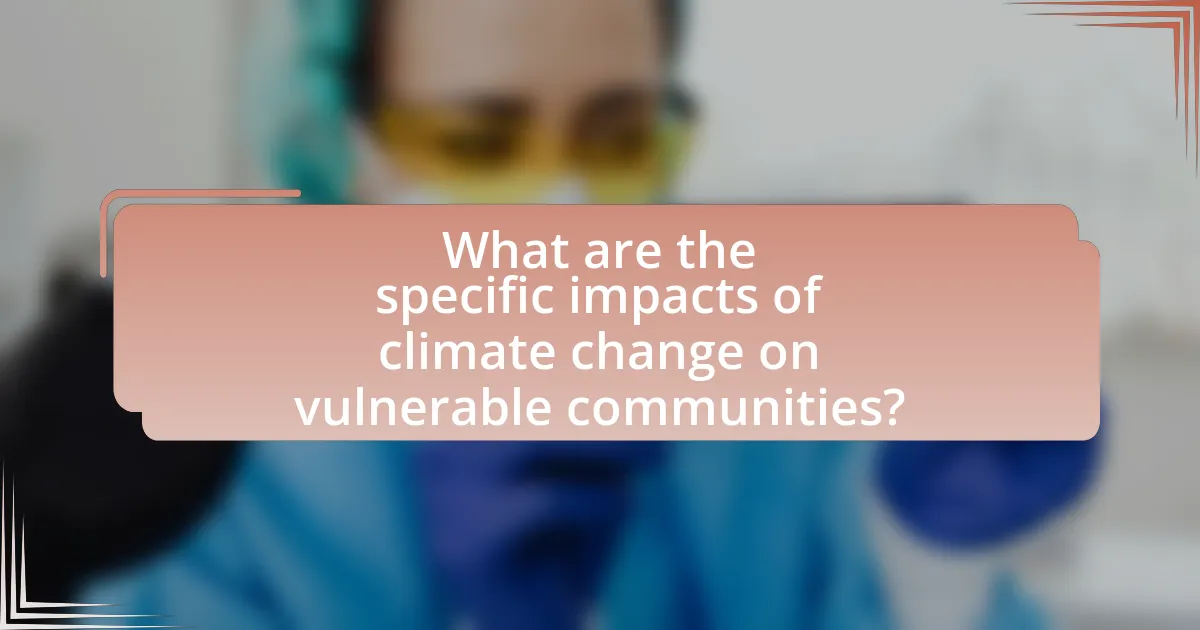
What are the specific impacts of climate change on vulnerable communities?
Climate change significantly impacts vulnerable communities by exacerbating existing inequalities and increasing their exposure to environmental hazards. These communities often face heightened risks such as food insecurity due to disrupted agricultural production, increased health issues from heatwaves and vector-borne diseases, and displacement from extreme weather events like floods and hurricanes. For instance, according to the Intergovernmental Panel on Climate Change (IPCC), low-income populations are more likely to suffer from malnutrition as climate change affects crop yields, leading to a projected increase in food prices. Additionally, vulnerable communities often lack the resources to adapt to these changes, resulting in a cycle of poverty and vulnerability that is difficult to escape.
How does climate change disproportionately affect these communities?
Climate change disproportionately affects vulnerable communities by exacerbating existing social, economic, and health disparities. These communities often lack the resources to adapt to climate impacts, such as extreme weather events, rising sea levels, and food insecurity. For instance, a report by the National Oceanic and Atmospheric Administration indicates that low-income neighborhoods are more likely to experience flooding and heatwaves, leading to increased health risks and economic losses. Additionally, marginalized groups often have limited access to healthcare and social services, making it harder for them to recover from climate-related disasters. This systemic inequity highlights the urgent need for targeted climate justice initiatives to support these communities effectively.
What are the health impacts of climate change on vulnerable populations?
Climate change significantly impacts the health of vulnerable populations by exacerbating existing health disparities and increasing the risk of various health issues. Vulnerable groups, including low-income communities, the elderly, and those with pre-existing health conditions, face heightened exposure to climate-related hazards such as extreme heat, air pollution, and vector-borne diseases. For instance, the World Health Organization estimates that climate change will cause an additional 250,000 deaths per year between 2030 and 2050 due to malnutrition, malaria, diarrhea, and heat stress, disproportionately affecting those in disadvantaged socio-economic positions. Furthermore, increased frequency and severity of natural disasters can lead to mental health issues, displacement, and loss of access to healthcare services, further compounding the health risks faced by these populations.
How does climate change affect economic stability in these communities?
Climate change significantly undermines economic stability in vulnerable communities by increasing the frequency and severity of extreme weather events, which disrupt local economies. For instance, rising sea levels and intensified storms can damage infrastructure, displace populations, and reduce agricultural productivity, leading to job losses and decreased income. According to the Intergovernmental Panel on Climate Change (IPCC), climate-related disasters have caused economic losses exceeding $300 billion annually, disproportionately affecting low-income areas that lack resources for recovery. This economic instability is compounded by the rising costs of adaptation and mitigation efforts, further straining community finances and exacerbating existing inequalities.
What role do grassroots movements play in climate justice?
Grassroots movements play a crucial role in climate justice by amplifying the voices of marginalized communities disproportionately affected by climate change. These movements mobilize local populations to advocate for equitable policies, raise awareness about environmental injustices, and demand accountability from governments and corporations. For instance, the Standing Rock Sioux Tribe’s protest against the Dakota Access Pipeline highlighted the intersection of indigenous rights and environmental protection, drawing global attention to the need for sustainable practices that respect local ecosystems and communities. Additionally, grassroots organizations often engage in direct action, community education, and coalition-building, which empower individuals to participate in decision-making processes that affect their lives and environments. This grassroots activism is essential for creating systemic change and ensuring that climate policies are inclusive and just.
How can community-led initiatives enhance mitigation efforts?
Community-led initiatives enhance mitigation efforts by fostering local engagement and ownership, which leads to more effective and sustainable climate action. When communities actively participate in designing and implementing mitigation strategies, they are more likely to address specific local needs and conditions, resulting in tailored solutions that are more effective than top-down approaches. For instance, a study by the United Nations Development Programme highlighted that community-driven projects in renewable energy not only reduced carbon emissions but also improved local livelihoods, demonstrating the dual benefits of such initiatives. Furthermore, these initiatives often mobilize local knowledge and resources, creating a sense of responsibility and commitment among community members, which is crucial for long-term success in climate mitigation.
What are successful examples of grassroots movements in vulnerable communities?
Successful examples of grassroots movements in vulnerable communities include the Dakota Access Pipeline protests led by the Standing Rock Sioux Tribe, which successfully halted the pipeline’s construction due to environmental concerns. This movement highlighted the importance of indigenous rights and environmental justice, mobilizing thousands to advocate for clean water and land protection. Another example is the Climate Justice Alliance, which unites various grassroots organizations to address climate change impacts on marginalized communities, advocating for equitable policies and sustainable practices. These movements demonstrate the power of community organizing in effecting change and raising awareness about climate justice issues.
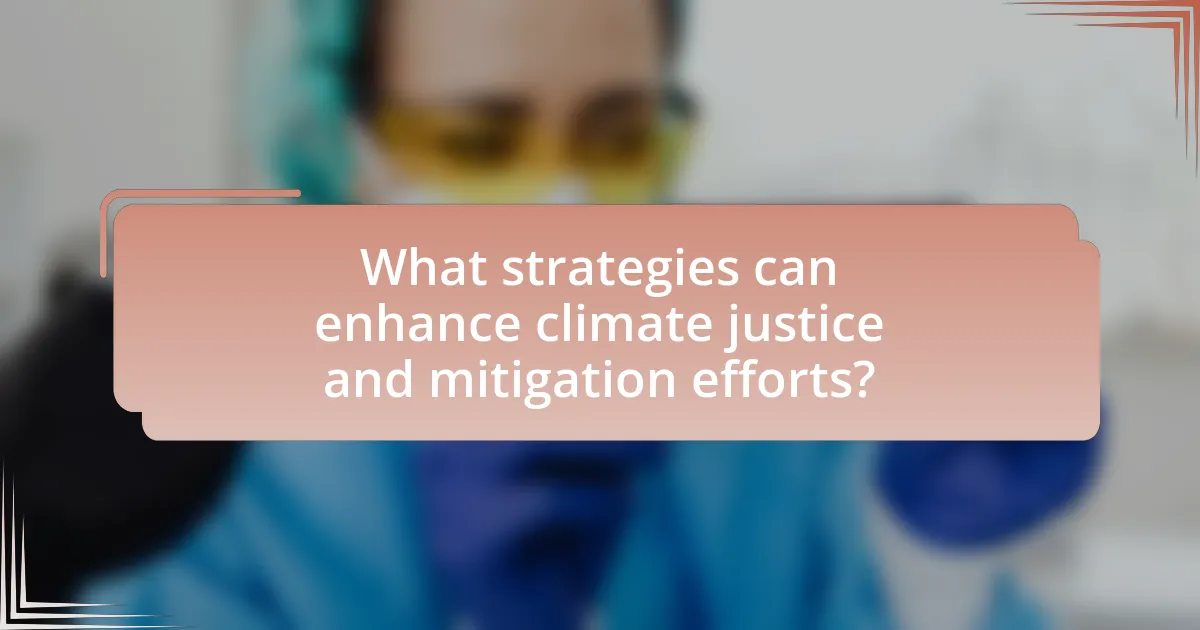
What strategies can enhance climate justice and mitigation efforts?
Strategies that can enhance climate justice and mitigation efforts include implementing equitable policy frameworks, promoting community-led initiatives, and ensuring access to clean energy technologies. Equitable policy frameworks address the disproportionate impacts of climate change on marginalized communities by integrating their voices into decision-making processes. Community-led initiatives empower local populations to develop tailored solutions that reflect their unique needs and circumstances, fostering resilience. Access to clean energy technologies, such as solar and wind power, enables vulnerable communities to reduce their carbon footprint while improving their economic conditions. Research indicates that inclusive climate policies can lead to more effective mitigation outcomes, as seen in the 2021 report by the Intergovernmental Panel on Climate Change, which emphasizes the importance of equity in climate action.
How can collaboration between stakeholders improve outcomes?
Collaboration between stakeholders can significantly improve outcomes by fostering shared resources, knowledge, and expertise, which leads to more effective climate justice initiatives. When diverse stakeholders, including government agencies, non-profits, and community organizations, work together, they can leverage their unique strengths to address the complex challenges faced by vulnerable communities. For instance, a study by the United Nations Development Programme highlights that collaborative approaches in climate adaptation projects have resulted in a 30% increase in project effectiveness compared to isolated efforts. This synergy not only enhances the implementation of mitigation strategies but also ensures that the voices of marginalized groups are included, leading to more equitable and sustainable solutions.
What roles do governments, NGOs, and local communities play in this collaboration?
Governments, NGOs, and local communities each play critical roles in the collaboration for climate justice and mitigation efforts. Governments establish policies and regulations that create frameworks for climate action, allocate funding, and implement programs aimed at reducing emissions and enhancing resilience in vulnerable communities. For example, national governments may commit to international climate agreements, such as the Paris Agreement, which sets targets for reducing greenhouse gas emissions.
NGOs contribute by advocating for marginalized voices, providing expertise, and facilitating community engagement. They often serve as intermediaries, connecting local communities with resources and information necessary for effective climate action. For instance, organizations like Greenpeace and the World Wildlife Fund work on the ground to implement sustainable practices and educate communities about climate impacts.
Local communities are essential as they possess firsthand knowledge of their environmental challenges and can implement localized solutions. Their involvement ensures that climate initiatives are culturally relevant and address specific needs. Community-led projects, such as reforestation or sustainable agriculture, demonstrate effective grassroots responses to climate change.
Together, these entities create a multi-faceted approach to climate justice, ensuring that efforts are inclusive, effective, and tailored to the unique circumstances of vulnerable populations.
How can funding and resources be effectively allocated to support these efforts?
Funding and resources can be effectively allocated to support climate justice and mitigation efforts in vulnerable communities by prioritizing community-led initiatives and ensuring equitable distribution based on need. Research indicates that when funding is directed towards projects that involve local stakeholders, such as community organizations and residents, the outcomes are more sustainable and impactful. For instance, a study by the Climate Justice Alliance highlights that community-driven projects not only address immediate environmental concerns but also foster long-term resilience, demonstrating that local engagement leads to better resource utilization. Additionally, implementing transparent funding mechanisms that assess vulnerability and climate risk can ensure that resources reach the most affected populations, thereby enhancing the effectiveness of climate mitigation strategies.
What best practices can be adopted for effective climate justice initiatives?
Effective climate justice initiatives should prioritize community engagement, equitable resource distribution, and policy advocacy. Community engagement ensures that the voices of marginalized populations are heard, allowing initiatives to be tailored to their specific needs. Equitable resource distribution addresses historical injustices by allocating funding and support to those most affected by climate change, such as low-income and minority communities. Policy advocacy is crucial for influencing legislation that promotes environmental justice and sustainability. Research indicates that initiatives incorporating these practices lead to more successful outcomes, as seen in the 2019 report by the United Nations Environment Programme, which highlights the importance of inclusive decision-making in climate action.
How can education and awareness campaigns empower vulnerable communities?
Education and awareness campaigns empower vulnerable communities by providing essential knowledge and skills that enhance their capacity to address climate-related challenges. These campaigns inform individuals about climate change impacts, adaptation strategies, and available resources, enabling them to make informed decisions. For instance, a study by the United Nations Development Programme highlights that communities engaged in educational initiatives are better equipped to implement sustainable practices, leading to improved resilience against climate impacts. Furthermore, awareness campaigns foster community solidarity and collective action, which are crucial for advocating for policy changes that benefit these communities.
What are the key elements of successful policy advocacy for climate justice?
The key elements of successful policy advocacy for climate justice include clear messaging, stakeholder engagement, evidence-based research, and coalition building. Clear messaging ensures that the goals and impacts of climate justice are communicated effectively to policymakers and the public, fostering understanding and support. Stakeholder engagement involves collaborating with affected communities, ensuring their voices and needs are prioritized in policy discussions. Evidence-based research provides the necessary data and case studies to support advocacy efforts, demonstrating the urgency and importance of climate justice initiatives. Coalition building brings together diverse groups, amplifying the advocacy efforts and increasing influence on policy decisions. These elements are essential for creating impactful and sustainable climate justice policies that address the needs of vulnerable communities.
What practical steps can individuals take to support climate justice in their communities?
Individuals can support climate justice in their communities by advocating for equitable policies that address the needs of marginalized groups affected by climate change. Engaging in local activism, such as participating in community meetings or joining organizations focused on environmental justice, empowers individuals to influence decision-making processes. Additionally, individuals can educate themselves and others about the impacts of climate change on vulnerable populations, fostering awareness and solidarity. Supporting local sustainable businesses and initiatives that prioritize environmental equity also contributes to community resilience. According to the United Nations, climate change disproportionately affects low-income communities, highlighting the importance of inclusive approaches to climate action.
